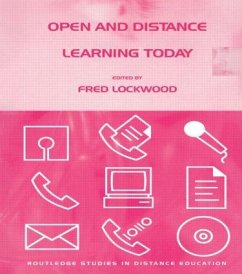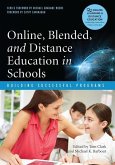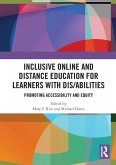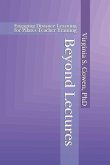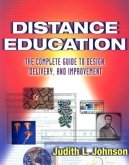Open and Distance Learning Today
Herausgeber: Lockwood, Fred
Open and Distance Learning Today
Herausgeber: Lockwood, Fred
- Broschiertes Buch
- Merkliste
- Auf die Merkliste
- Bewerten Bewerten
- Teilen
- Produkt teilen
- Produkterinnerung
- Produkterinnerung
Fred Lockwood presents a comprehensive account of research and development in open, distance and flexible learning from a range of acknowledged experts from around the world. An essential purchase for teachers and students alike.
Andere Kunden interessierten sich auch für
![Distance Education: New Perspectives Distance Education: New Perspectives]() Distance Education: New Perspectives65,99 €
Distance Education: New Perspectives65,99 €![Online, Blended, and Distance Education in Schools Online, Blended, and Distance Education in Schools]() Online, Blended, and Distance Education in Schools50,99 €
Online, Blended, and Distance Education in Schools50,99 €![Otto Peters on Distance Education Otto Peters on Distance Education]() Otto Peters on Distance Education26,99 €
Otto Peters on Distance Education26,99 €![Inclusive Online and Distance Education for Learners with Dis/abilities Inclusive Online and Distance Education for Learners with Dis/abilities]() Inclusive Online and Distance Education for Learners with Dis/abilities53,99 €
Inclusive Online and Distance Education for Learners with Dis/abilities53,99 €![Beyond Lectures: Engaging Distance Learning for Pilates Teacher Training Beyond Lectures: Engaging Distance Learning for Pilates Teacher Training]() Virginia CowenBeyond Lectures: Engaging Distance Learning for Pilates Teacher Training30,99 €
Virginia CowenBeyond Lectures: Engaging Distance Learning for Pilates Teacher Training30,99 €![Letters And Bytes: Sociotechnical Studies Of Distance Education Letters And Bytes: Sociotechnical Studies Of Distance Education]() Francis LeeLetters And Bytes: Sociotechnical Studies Of Distance Education19,99 €
Francis LeeLetters And Bytes: Sociotechnical Studies Of Distance Education19,99 €![Distance Education: The Complete Guide to Design, Delivery, and Improvement Distance Education: The Complete Guide to Design, Delivery, and Improvement]() Judith L. JohnsonDistance Education: The Complete Guide to Design, Delivery, and Improvement37,99 €
Judith L. JohnsonDistance Education: The Complete Guide to Design, Delivery, and Improvement37,99 €-
-
-
Fred Lockwood presents a comprehensive account of research and development in open, distance and flexible learning from a range of acknowledged experts from around the world. An essential purchase for teachers and students alike.
Hinweis: Dieser Artikel kann nur an eine deutsche Lieferadresse ausgeliefert werden.
Hinweis: Dieser Artikel kann nur an eine deutsche Lieferadresse ausgeliefert werden.
Produktdetails
- Produktdetails
- Verlag: Taylor & Francis
- Seitenzahl: 394
- Erscheinungstermin: 15. Juni 1995
- Englisch
- Abmessung: 234mm x 156mm x 21mm
- Gewicht: 553g
- ISBN-13: 9780415127592
- ISBN-10: 0415127599
- Artikelnr.: 21105801
- Herstellerkennzeichnung
- Libri GmbH
- Europaallee 1
- 36244 Bad Hersfeld
- gpsr@libri.de
- Verlag: Taylor & Francis
- Seitenzahl: 394
- Erscheinungstermin: 15. Juni 1995
- Englisch
- Abmessung: 234mm x 156mm x 21mm
- Gewicht: 553g
- ISBN-13: 9780415127592
- ISBN-10: 0415127599
- Artikelnr.: 21105801
- Herstellerkennzeichnung
- Libri GmbH
- Europaallee 1
- 36244 Bad Hersfeld
- gpsr@libri.de
Fred Lockwood
I: Trends and Directions
1: The Big Bang Theory in Distance Education
2: A Practical Agenda for Theorists of Distance Education
3: Trends, Directions and Needs
4: American Distance Education
5: Creating the Future
II: The Student Experience
6: Student Learning and Students' Experiences
7: The Potential of Research with Students to Inform Development
8: Still Seeking the Audience?
III: Information Technology
9: Information Technology and Disabled Students
10: See What i Mean?
11: Teaching and Learning by Satellite in a European Virtual Classroom
12: A Dimension of Image Types in Educational Multimedia Materials
IV: Learner Use of Media
13: Over the Threshold
14: The Empathy Templates
15: Electronic Highway or Weaving Loom?
16: Use of Hypermedia and Telecommunications for Case-Study Discussions in Distance Education
V: Course Design and Assessment
17: The Challenge Facing Course Design
18: A Model-Based Design Approach for the Flexibilisation of Courses
19: Students' Perception of, and Response to, Formative and Summative Assessment Material
20: Using Electronic Networking for Assessment
VI: Learner Support and Management
21: Research and Pragmatism in Learner Support
22: Student Support in Open and Distance Learning
23: Support for the In-Company Learner
24: Implementing Experiences From Small-Scale Courses to Large Education Systems
25: Managing Learning Support
VII: Textual Materials
VII 26: The Layout and Design of Textual Materials for Distance Learning
VII 27: Using Instructional Illustrations for Distance Education
VII 28: The Development of Printed Materials
VII 29: Contemporary Developments in the Typographical Design of Instructional Texts for open and Distance Learning
VII 30: Electronic Layout and Design Visions of the Future
VIII: Evaluation and Quality
VIII 31: Building Good Quality in, Rather than Inspecting Bad Quality out
VIII 32: Course Evaluation and Academic Quality
VIII 33: A String of Pearls? A Broader Approach to Course Evaluation
VIII 34: Evaluation and Self-improving Systems
1: The Big Bang Theory in Distance Education
2: A Practical Agenda for Theorists of Distance Education
3: Trends, Directions and Needs
4: American Distance Education
5: Creating the Future
II: The Student Experience
6: Student Learning and Students' Experiences
7: The Potential of Research with Students to Inform Development
8: Still Seeking the Audience?
III: Information Technology
9: Information Technology and Disabled Students
10: See What i Mean?
11: Teaching and Learning by Satellite in a European Virtual Classroom
12: A Dimension of Image Types in Educational Multimedia Materials
IV: Learner Use of Media
13: Over the Threshold
14: The Empathy Templates
15: Electronic Highway or Weaving Loom?
16: Use of Hypermedia and Telecommunications for Case-Study Discussions in Distance Education
V: Course Design and Assessment
17: The Challenge Facing Course Design
18: A Model-Based Design Approach for the Flexibilisation of Courses
19: Students' Perception of, and Response to, Formative and Summative Assessment Material
20: Using Electronic Networking for Assessment
VI: Learner Support and Management
21: Research and Pragmatism in Learner Support
22: Student Support in Open and Distance Learning
23: Support for the In-Company Learner
24: Implementing Experiences From Small-Scale Courses to Large Education Systems
25: Managing Learning Support
VII: Textual Materials
VII 26: The Layout and Design of Textual Materials for Distance Learning
VII 27: Using Instructional Illustrations for Distance Education
VII 28: The Development of Printed Materials
VII 29: Contemporary Developments in the Typographical Design of Instructional Texts for open and Distance Learning
VII 30: Electronic Layout and Design Visions of the Future
VIII: Evaluation and Quality
VIII 31: Building Good Quality in, Rather than Inspecting Bad Quality out
VIII 32: Course Evaluation and Academic Quality
VIII 33: A String of Pearls? A Broader Approach to Course Evaluation
VIII 34: Evaluation and Self-improving Systems
I: Trends and Directions
1: The Big Bang Theory in Distance Education
2: A Practical Agenda for Theorists of Distance Education
3: Trends, Directions and Needs
4: American Distance Education
5: Creating the Future
II: The Student Experience
6: Student Learning and Students' Experiences
7: The Potential of Research with Students to Inform Development
8: Still Seeking the Audience?
III: Information Technology
9: Information Technology and Disabled Students
10: See What i Mean?
11: Teaching and Learning by Satellite in a European Virtual Classroom
12: A Dimension of Image Types in Educational Multimedia Materials
IV: Learner Use of Media
13: Over the Threshold
14: The Empathy Templates
15: Electronic Highway or Weaving Loom?
16: Use of Hypermedia and Telecommunications for Case-Study Discussions in Distance Education
V: Course Design and Assessment
17: The Challenge Facing Course Design
18: A Model-Based Design Approach for the Flexibilisation of Courses
19: Students' Perception of, and Response to, Formative and Summative Assessment Material
20: Using Electronic Networking for Assessment
VI: Learner Support and Management
21: Research and Pragmatism in Learner Support
22: Student Support in Open and Distance Learning
23: Support for the In-Company Learner
24: Implementing Experiences From Small-Scale Courses to Large Education Systems
25: Managing Learning Support
VII: Textual Materials
VII 26: The Layout and Design of Textual Materials for Distance Learning
VII 27: Using Instructional Illustrations for Distance Education
VII 28: The Development of Printed Materials
VII 29: Contemporary Developments in the Typographical Design of Instructional Texts for open and Distance Learning
VII 30: Electronic Layout and Design Visions of the Future
VIII: Evaluation and Quality
VIII 31: Building Good Quality in, Rather than Inspecting Bad Quality out
VIII 32: Course Evaluation and Academic Quality
VIII 33: A String of Pearls? A Broader Approach to Course Evaluation
VIII 34: Evaluation and Self-improving Systems
1: The Big Bang Theory in Distance Education
2: A Practical Agenda for Theorists of Distance Education
3: Trends, Directions and Needs
4: American Distance Education
5: Creating the Future
II: The Student Experience
6: Student Learning and Students' Experiences
7: The Potential of Research with Students to Inform Development
8: Still Seeking the Audience?
III: Information Technology
9: Information Technology and Disabled Students
10: See What i Mean?
11: Teaching and Learning by Satellite in a European Virtual Classroom
12: A Dimension of Image Types in Educational Multimedia Materials
IV: Learner Use of Media
13: Over the Threshold
14: The Empathy Templates
15: Electronic Highway or Weaving Loom?
16: Use of Hypermedia and Telecommunications for Case-Study Discussions in Distance Education
V: Course Design and Assessment
17: The Challenge Facing Course Design
18: A Model-Based Design Approach for the Flexibilisation of Courses
19: Students' Perception of, and Response to, Formative and Summative Assessment Material
20: Using Electronic Networking for Assessment
VI: Learner Support and Management
21: Research and Pragmatism in Learner Support
22: Student Support in Open and Distance Learning
23: Support for the In-Company Learner
24: Implementing Experiences From Small-Scale Courses to Large Education Systems
25: Managing Learning Support
VII: Textual Materials
VII 26: The Layout and Design of Textual Materials for Distance Learning
VII 27: Using Instructional Illustrations for Distance Education
VII 28: The Development of Printed Materials
VII 29: Contemporary Developments in the Typographical Design of Instructional Texts for open and Distance Learning
VII 30: Electronic Layout and Design Visions of the Future
VIII: Evaluation and Quality
VIII 31: Building Good Quality in, Rather than Inspecting Bad Quality out
VIII 32: Course Evaluation and Academic Quality
VIII 33: A String of Pearls? A Broader Approach to Course Evaluation
VIII 34: Evaluation and Self-improving Systems

